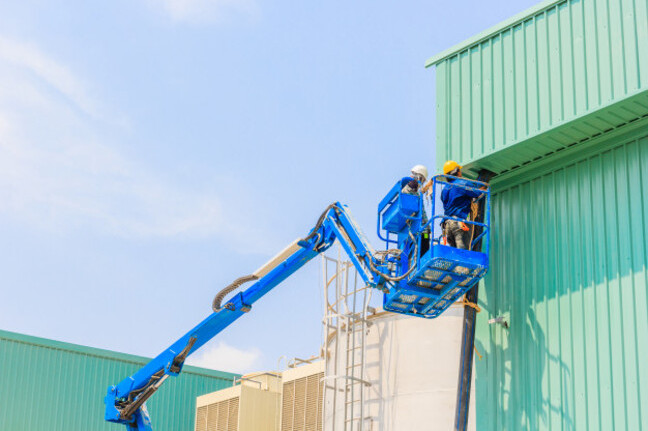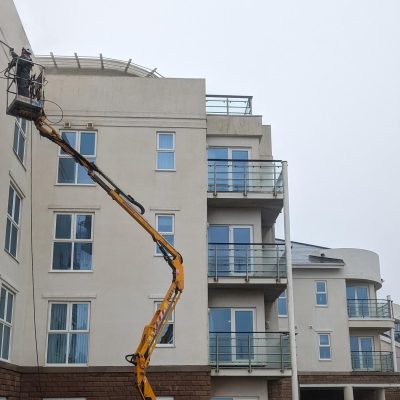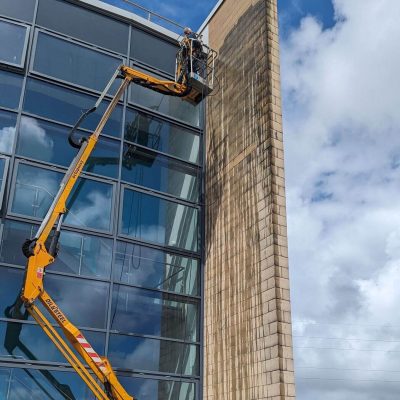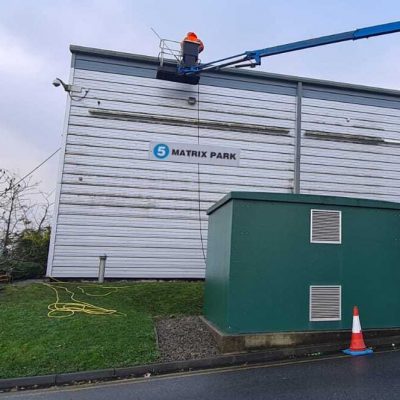As a manager, being knowledgeable about the equipment your team uses is crucial for compliancy, safety and efficiency. One common type of equipment for working at heights is a mobile elevated work platform (MEWP).
If your team use MEWPs, it’s important for you to understand what they are, different types available, safety considerations, training requirements, and maintenance needs.
So let’s start with the basic –
What is a MEWP?
A mobile elevated work platform is essentially a mechanised device used to provide temporary access for people and equipment to inaccessible areas, usually at height. MEWPs are designed to lift operators to the elevated work area using a boom, scissor, or mast structure.
MEWPs are considered as an alternative to ladders, scaffolding, etc.
Types of MEWPs:
Vertical lift platforms:
- Mast structure extends vertically to position platform at height
- Often called AWPs (aerial work platforms)
- Excellent overhead reach straight up
- Ideal for exterior construction and maintenance
Examples:
- Scissor lifts
- Articulating booms
- Telescopic booms
Scissor lifts:
- Scissor mechanism raises platform vertically
- Compact size accesses tight spaces
- Allow reaching edge of elevated surfaces
- Lightweight and highly manoeuvrable
Ideal for:
- Indoor construction and maintenance
- Accessing high shelves and racks
- Overhead work near edges
Boom lifts:
- Articulating arm extends horizontally
- Provides access to hard-to-reach areas
- Platform rotates and elevates
- Trailer-mounted models highly portable
Ideal for:
- Exterior construction and maintenance
- High access over obstacles
- Reaching far horizontally from stable base

Cherry pickers:
- Boom lift with enclosed platform
- Can rotate and extend over barriers
- Provides overhead protection
Ideal for:
- Construction and inspection
- Utility and lighting maintenance
- Anywhere workers need overhead protection
MEWPs run on electric, diesel, or gas power. They are designed to be self-propelled for manoeuvring around worksites. Most models have extending decks or platforms with railings for safely lifting personnel and materials to overhead work areas.
Compared to ladders and scaffolding, MEWPs provide safer, more efficient access for working at height. They also involve less labour for setup and allow reaching over obstacles.
This makes them a useful modern tool for construction, maintenance, inspection, and other elevated access needs.
Why Use MEWPs?
As we discussed above, MEWPs are:
| Safe | MEWPs provide a safer working environment than ladders and scaffolding. Operators are protected by railings and fall prevention mechanisms. |
| Flexible | MEWPs are highly manoeuvrable and versatile. Their booms and platforms can extend over obstacles, reach work areas inaccessible by ladders. And provide stable elevated access exactly where needed. This flexibility improves productivity. |
| Efficient | Setup and tear down of MEWPs is far faster than scaffolding. No time is wasted constructing complex scaffolding to access a work area. Operators simply drive into position and elevate. This saves significant time and labour costs. |
| Overhead access | Tasks like exterior construction, maintenance, and inspection often require overhead reach. MEWPs allow this safe overhead access without cranes. |
| Accessible | Scissor lifts allow access right to the edge of elevated platforms, enabling close access to vertical surfaces which other equipment can’t reach. |
For any job requiring temporary work access above ground level, MEWPs generally provide the optimal blend of safety, flexibility, efficiency, and accessibility.
Key Safety Considerations
While MEWPs provide much safer elevated access than ladders or scaffolding, they still present serious hazards if not operated properly. As a manager, you must ensure operators are fully trained and follow essential safety practices, including:
- Thorough pre-operation inspection
- Checking the work area for hazards like power lines
- Following load limits for personnel and materials
- Proper setup, anchoring, and outrigger deployment
- Keeping floors clear of debris
- Caution when moving with the platform raised
- Proper use of fall protection harnesses and lanyards
- No improvised modifications or overreaching from platforms
It’s critical to establish and enforce strict safety protocols for all MEWP use, tailored to the specific models your team uses. Safety should always be the top priority when working at height.
Operator Training Requirements
Elevated work platforms can only be safely operated by personnel with proper training. Industry associations like IPAF provide training programs for different types of MEWPs.
Confirm your team members have appropriate training documentation from accredited programs before allowing them to operate any type of MEWP. Proper training is crucial for preventing accidents and injuries.
IPAF also provides training for managers i.e. According to their website “Employers, project managers, foremen and supervisors working in a broad range of industries such as construction, facilities management, retail, airports and arboriculture. Anyone who is responsible for planning and overseeing the use of MEWPs on their job site.”
Moving forward to –
Inspection, Maintenance Requirements & Best Practices for Managers
To safely and effectively oversee teams using MEWPs, as a manager, it’s your key responsibility to:
- Maintain accurate equipment logs to track inspections, repairs, and maintenance.
- Provide an adequate budget for preventative maintenance, repairs, and replacements. Outdated equipment jeopardises safety.
- Document all operator training records. Confirm licences are current before allowing use.
- Conduct work site walkthroughs to identify hazards that could impact safe MEWP operation.
- Standardise lift operating procedures across projects and crews. Consistency improves safety.
- Investigate and document all MEWP-related incidents thoroughly. Identify root causes and preventative actions.
- Suspend use of faulty or damaged equipment immediately until repaired by a qualified technician.
- Enforce zero tolerance for shortcuts, improvisation, or unsafe acts when working in MEWPs.
Following these management best practices will help you oversee their safe, efficient use on your projects.



